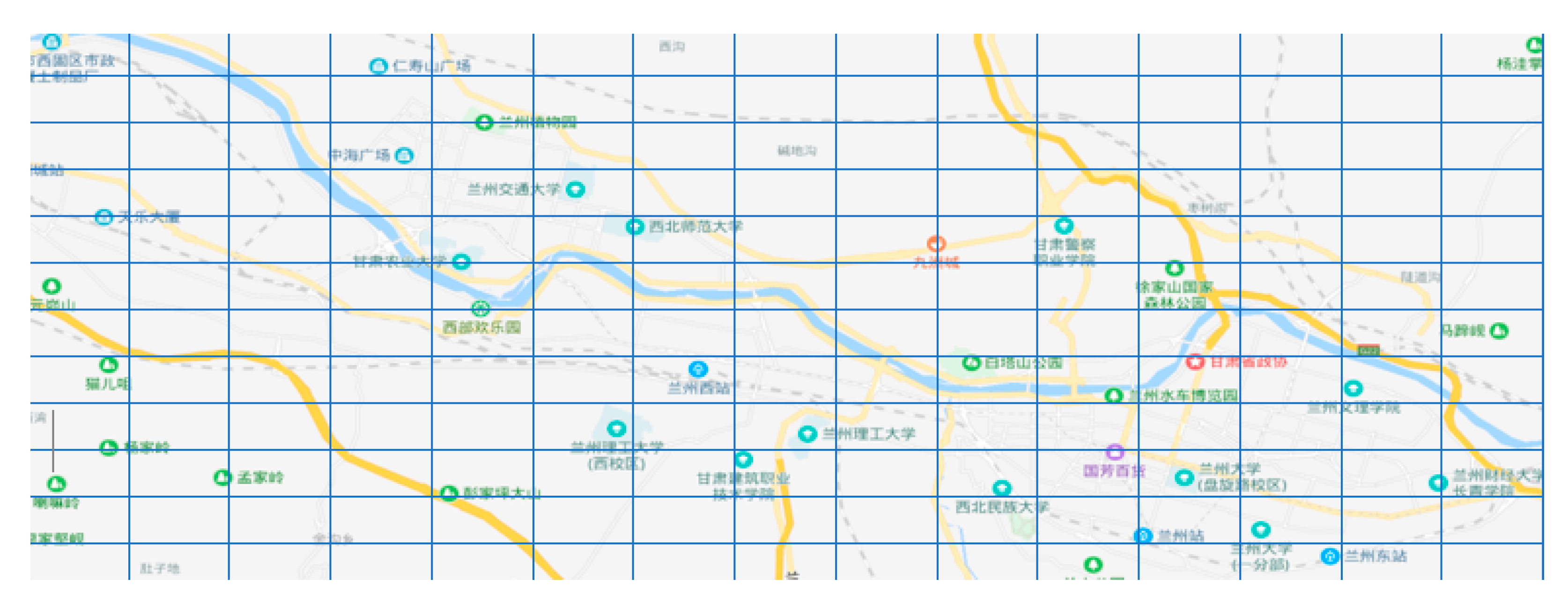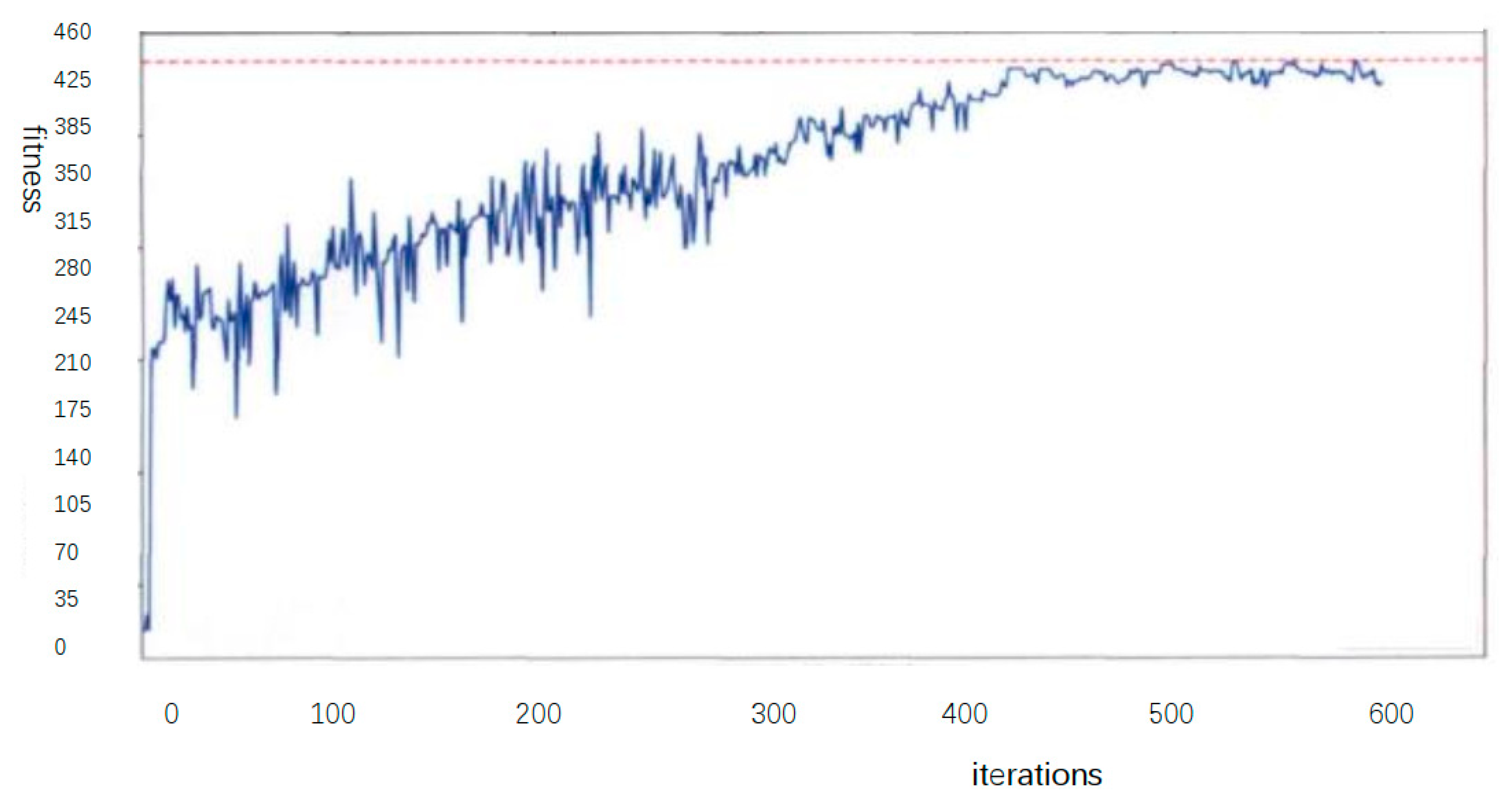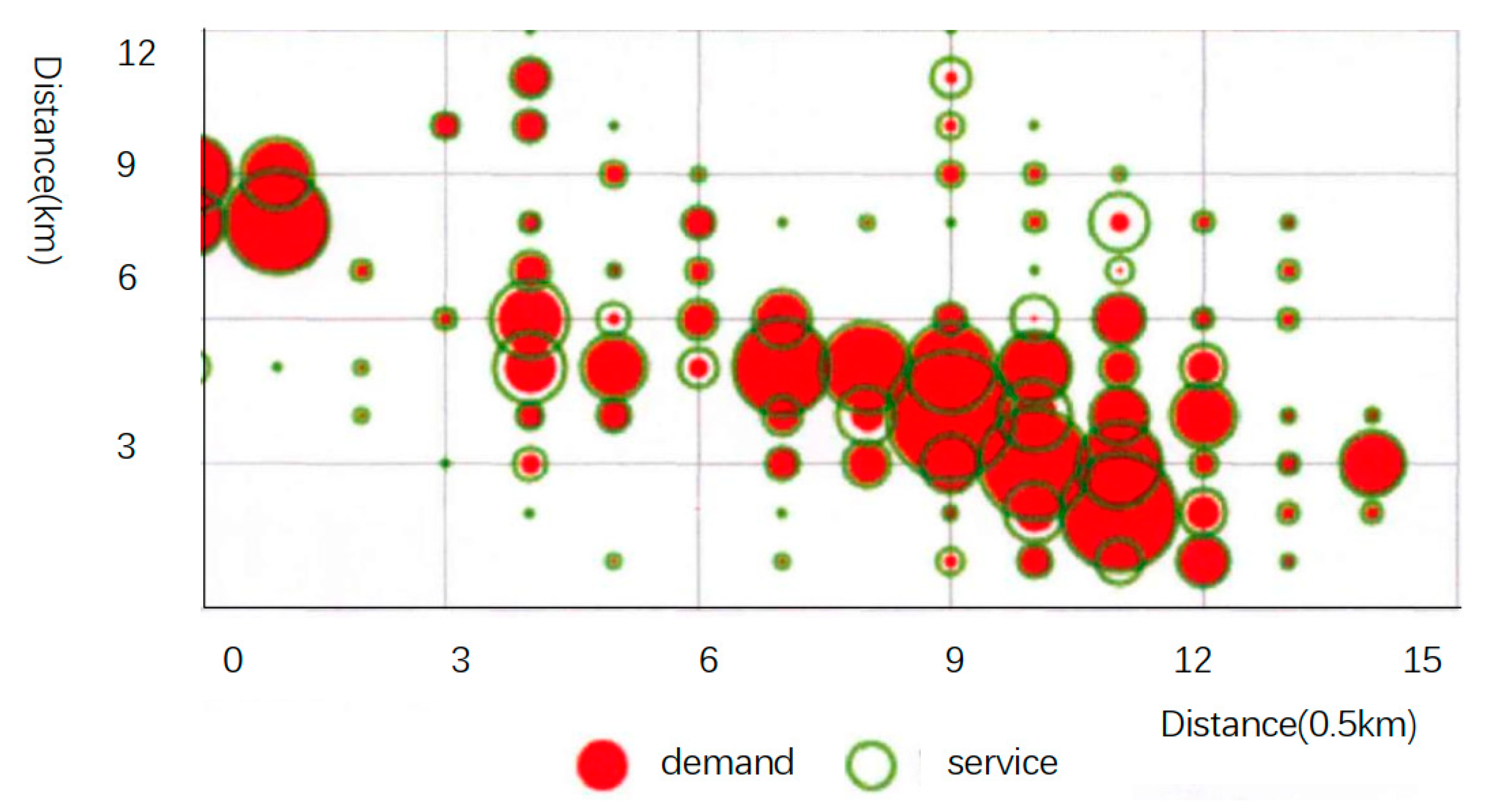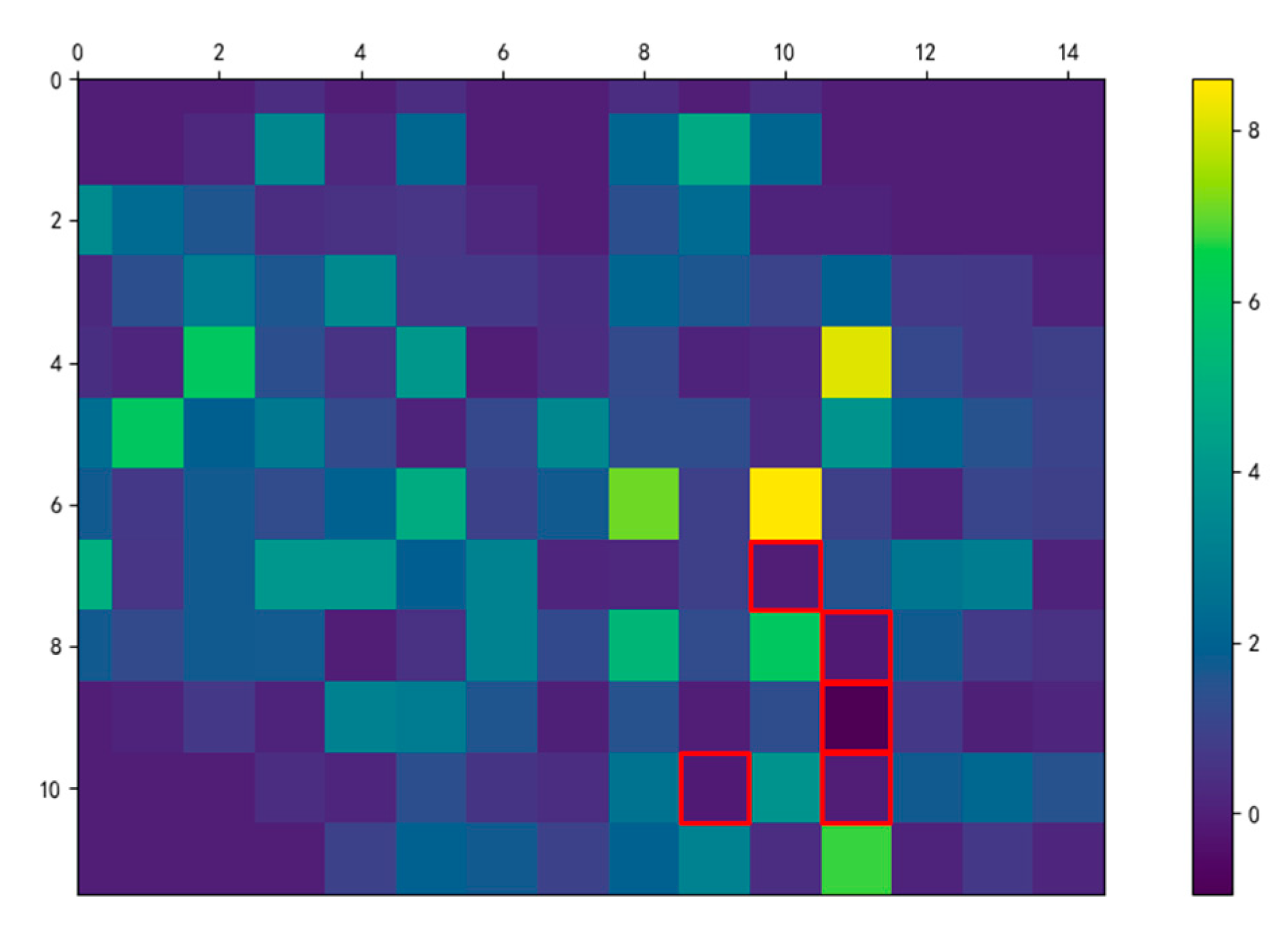1. Introduction
Carsharing is gaining popularity due to its green advantages. Carsharing helps reduce the number of private cars, which alleviates traffic congestion in turn [
1]. Carsharing refers to the leasing business in which cars are owned by a carsharing company and used by different users at varying times with measurement by duration and mileage. Unlike traditional offline car rental service and day-by-day billing units, carsharing users register and authenticate on their mobile phones, use applications to find surrounding stations, and rent cars by time [
2]. This research analyzes electric carsharing, which is a carsharing that is powered by electricity and has less pollution impact than traditional cars.
This research focuses on the types of electric carsharing [
3,
4] in which the cars can be fetched and parked at fix or free stations. Fix stations require a certain area to store cars, and the costs include land rent, charger and station construction costs [
5,
6]. If the area does not have fix stations, then users can park their cars on the public parking space in a certain area. Different fees of users are charged for parking at varying stations. However, the parking fee is paid by the company. Therefore, for the carsharing company, the free station does not require the cost of station construction, but parking costs will be incurred. The construction of fixed stations is conducive to the management of cars, and free stations are convenient for users to use cars and for reducing the cost of station construction. The combination of two operation forms is conducive to the sustainable development of carsharing.
Carsharing is advantageous because it provides great convenience for users and improves the flexibility of cars [
7]. Zhu [
8] analyzed the objective conditions of the new energy carsharing in China and revealed the popularization value and prospects of carsharing in China. Feng [
9] analyzed the current development status and future scale of the major car long-term rental, short-term rental, and online car rental markets. These studies are biased toward policy and market analysis. Notably, carsharing has a great future in the transportation field. However, the development of the carsharing industry is still in its early stages. The problems of few stations, few available cars, and few chargers have become key restricting factors of the development of carsharing companies [
10]. Some studies have found that carsharing network settings can affect user willingness and company development. Ciari [
11] used a binary logistic model and showed that the location of stations actually affects potential membership. This research used elastic analysis to find the relationship between distance and number of users but did not introduce specific methods for station location optimization. Correia [
12] found that financial losses can be reduced through appropriate choices with respect to the number, location, and size of the depots. This research provided the foundation for the necessity of the station location optimization model.
Scholars have conducted the following research to address the problems of carsharing station location optimization. Jiang [
13] used analytic hierarchy process to calculate the best scheme for carsharing stations. The study identified variables with a significant effect on station location selection but did not build an optimization model for carsharing station location determination. Lu [
14] used the interval fuzzy soft set method of risk preference for each carsharing station in Wang Cheng County. The evaluation of the plan has certain reference significance for the location and future planning of carsharing. This method is more suitable for evaluating existing carsharing stations than for planning for new cities. The above-mentioned research methods are relatively subjective. Other methods using mathematical models are presented as follows. Çalık [
15] illustrated a carsharing locating recharging station model that operates under demand uncertainty. The research developed a demand forecasting method that allows the generation of many demand scenarios. Hu [
16] formulated a mixed queuing network model for the joint design of fleet size and station capacities. The optimization problem was solved by the genetic algorithm. They proved that the profit is maximized when the existing road congestion is moderate. This research mainly considered the carsharing model of the fixed station but ignored the setting of free stations. Wielinski, G [
17] researched the travel area and behavior of free-floating carsharing users. This study mainly considered the operation model of free-floating carsharing but ignored the setting of fixed stations. Zheng [
18] proposed a method for optimizing the location of charging stations for one-way electric carsharing systems. The objective function was to maximize the profit of carsharing service. Simulations were performed to prove the effectiveness of the research method. The final station was optimized by 0–1 variable station selection among existing candidate sites. However, the study failed to provide scientific theoretical basis for the selection of the alternative station. Lee [
19] analyzed eight spatial elements related to carsharing location. A model was established to determine the optimal carsharing locations with the minimum total distance between carsharing users. This model took the minimum travel cost of the users as the optimization goal, which optimized the station location based on fixed station operations. Chen [
20] designed a genetic algorithm to solve the problem with the least total change and the smallest gap between supply and demand. The model results obtained the adjustment of the number of cars at each station after optimization. This model is more suitable for the scale expansion of a city that already has carsharing than for the location optimization of a new city. In this research, the electric carsharing location and car allocation model of fixed and free stations are considered first. This way improves not only the efficiency of electric carsharing management but also the convenience of user demands. Second, this study uses the grid division method for area discretization, which improves the shortcomings of random optimization of alternative stations based on alternative station optimization. To the best of the authors’ knowledge, this study is the first to integrate the above-mentioned method to carsharing location method.
Electric carsharing is an asset-heavy and high-risk industry. Networking is the development trend. The electric carsharing station network is not only crucial to the company’s profitability but also significant for the development of urban transportation systems [
21]. First, electric carsharing network is difficult to alter after completion due to its large investment. The geographical location of the network directly determines the network location and economic benefits of the company. Second, the current charging, parking space, and car license plate resources in the industry are limited. The location of the stations determines whether these resources can be fully utilized for reducing costs [
22].
This research analyzes the optimization model of the location of electric carsharing networks. The optimization model and application scenarios of electric carsharing are combined to determine the affecting factors of electric carsharing network station location. The objective function is to meet the maximum user demand with the limited cost of the company as the constraint while considering factors, such as land rent, parking prices, and the number of chargers. An optimization model for the location of electric carsharing is established. Then, the location plan of the network in the research area is obtained using genetic algorithm by analyzing the established nonlinear integer programming model. Finally, a case study is conducted. The results indicate that this research can improve the coverage ratio of user demand and the convenience of users. Accordingly, the competitiveness of the electric carsharing industry development can be enhanced. On the one hand, this research is important in promoting healthy development of the industry. On the other hand, this research can provide theoretical guidance for the station location of electric carsharing companies.
The remainder of the paper is organized as follows. In
Section 2, the data process is introduced.
Section 3 presents the electric carsharing location model and the solution of genetic algorithm in detail.
Section 4 demonstrates the case study and solution result. Conclusions and prospects are elaborated in
Section 5.
4. Case Study
4.1. Setting up the Case Study
Lanzhou is an important tourist city in China. The city is an important comprehensive transportation hub. At present, the resident population in Lanzhou City is more than 3.6 million, and the number of cars is more than 1.04 million. Urban transportation problems are prominent in the city because of the large population and cars. The spatial layout of Lanzhou is shown in
Figure 3.
Nowadays, the construction of electric carsharing stations is based on experience. Thus, optimization of the entire region is difficult. As a result, the company spends a lot of time and resources in operating. Therefore, the rational construction of an electric carsharing location model helps companies reduce blind investment and improve operating efficiency in station optimization. This research applies the location optimization model to optimize the electric carsharing station in Lanzhou.
4.2. Parameter Calibration
Lanzhou is a strip-shaped city. This research selects a rectangular research area of 30 km × 12 km in Lanzhou and divides the research area into small areas of 2 km × 1 km. A total of 15 × 12 area is obtained. The specific division is shown in
Figure 4.
The demand for electric carsharing D is obtained according to the survey done by the carsharing company. Seven types of land use, namely, transportation hubs, ordinary interchange point, business districts, college campuses, jobs, residential areas, and tourist attractions, have significant effects on the demand for electric carsharing. Using Equation (2), the final carsharing demand matrix is obtained.
We divide the area by a grid of 12 rows and 15 columns and set the fixed station placement plan
B as a matrix of 12 rows and 15 columns.
K is the free station placement plan. In this research, the location of the free station is preset. Therefore, the capacity of the free station needs to be optimized.
The service capacity
and demand
of a single car rental station are generally closely related to the location and capacity of the electric carsharing at the station. It is given by the electric carsharing company based on its own investment level and development strategy. Service intensity usually decreases as the distance to the center of the carsharing station increases. Thus, this research divides the district into core, secondary, and marginal districts. Then, the service matrix of each station can be constructed. This study supposes that a single station has same service capabilities
A.
V is the average monthly rent matrix per square meter in each small grid.
J is the parking price per hour in the free parking area.
The company intends to invest W = 50 million in these costs.
The cost of buying each car is b = 100,000 yuan.
The construction cost of each charger is e= 2000 yuan.
The average parking time for each car in the free parking area is t = 1440 h a year.
The corresponding coefficient μ = 20 of the area of the stations and the size of the stations.
The corresponding coefficient λ = 0.5 between the scale of the stations and the required number of chargers.
The maximum number of cars dropped at each station is 100.
We design a genetic optimization algorithm to solve the model. The calculation process of the algorithm is shown in
Figure 2. The corresponding parameters are set as follows:
The selection operator is tournament selection;
The crossover operator is single-point crossover;
The crossover probability is 0.8;
The mutation operator is multipoint mutation;
The mutation probability is 0.05;
The population size is set to 500;
The stop rule is set to a maximum of 600 iterations.
4.3. Results
The generated genetic algorithm iterative curve is shown in
Figure 5. The figure shows that the genetic algorithm iterative curve shows a rising trend, which is consistent with the optimization model established in this study. Specifically, before the 400th generation the speed of rising is evident, and the degree of dispersion is large. After the 400th generation, the curve is stable, and the fluctuations are reduced. The latter trend continues to the end of the iteration. Therefore, the genetic algorithm converges, and the optimal value of 426 of the stationary period is taken as the optimal solution of the algorithm.
Figure 6 shows the result of superimposing the service range of the electric carsharing network calculated by the genetic algorithm and the demand range of the demand matrix. As observed, the scope of requirements can be surrounded by the service matrix, which indicates that the requirements can be met. Furthermore, the demands are mainly distributed diagonally, which is similar to the demand matrix and the actual situation.
This research meets the overall demands of the city by placing cars in free stations or fixed stations, as shown in
Figure 7 and
Figure 8.
Figure 7 shows the demand range (left) and overall service ability (right) of free and fixed stations. The lighter the color, the larger the quantity, and vice versa.
Figure 8 shows the service capabilities and scope of fixed and free sites. The lighter the color, the greater the service capability, and vice versa.
Figure 9 presents the heat map for the final network of the stations. Color shades represent the number of services available minus the number of requirements. The figure shows that user demands can be met in most areas. Some cases in the red grid have demands that are not met.
The specific statistics of the station planning are shown in
Table 1. The entire area must be resettled at 56 regional points, of which two points are required to set stations at free and fixed stations. A maximum of 24 cars can be installed in a single area. A total of 425 vehicles are settled.
5. Conclusions and Prospects
The rapid development of the electric carsharing industry has made the way to locate and design electric carsharing stations a critical issue. This study analyzes the development status and existing problems of electric carsharing. An electric carsharing station location model is established in consideration of multiple influencing factors. The main factors for the demand of electric carsharing are summarized by studying the application scenarios and business models of electric carsharing. On the basis of these factors, a quantitative method that allocates cars according to travel demand is proposed. A model of station location is established on the basis of a two-dimensional spatial analysis. A genetic algorithm is designed to solve the problem given the characteristics of the model. The feasibility of the model and solution method is verified using a case study of Lanzhou.
This research can be used for carsharing station location optimization in a new city. A comprehensive station location optimization model is constructed by considering factors, such as the total number of people in the city, the proportion of travel modes, station construction costs, and construction budget. This method can also be used to study the locations of shared bicycles, electric vehicle charging piles, and logistics distribution points. Therefore, this method can be extended.
The station location problem of electric carsharing is a multi-disciplinary problem and has many influencing factors. On the basis of the analysis and summary of the development status of electric carsharing, this study establishes a network location model and the solution methods. The proposed methods can be improved from the following aspects. First, the forecast of the overall demand for electric carsharing in the region is insufficiently accurate. This study only quantitatively predicts the demand from several macro data indicators. Relatively few influencing factors are considered, and the correlation between the factors has not been studied and verified with examples. Further research is needed. Second, some parameters use an average estimation method that may be inconsistent with actual operations. Finally, the model also ignores the effect of other operators on the regional demand. These issues will be complemented in the future research.
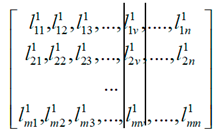 crossover with
crossover with  . Then, we obtain
. Then, we obtain  and
and  . Any row to row and column to column can crossover.
. Any row to row and column to column can crossover.


